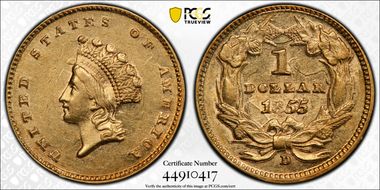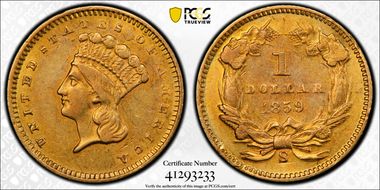TJK Family Collection 的钱币相册
An uncommonly attractive survivor of this challenging Type II gold dollar. Both sides exhibit bright honey-gold color with intermingled pale apricot highlights. Abundant frosty to semi-reflective luster remains to surfaces that reveal only a trace of rub, and no sizeable or otherwise singularly notable marks. The digit 8 is softly defined, and the hair curls above Liberty's brow are blunt and devoid of finer detail. Otherwise, however, we note bold to sharp detail throughout the design. The surfaces show clash marks in the fields around the central design elements, typical of the type. Preserved with uncommon care for an issue that suffered a high rate of attrition through circulation and melting, this is a superior 1855-D in all categories that is sure to please discerning bidders. The 1855-D is one of the rarest gold dollars struck at the Dahlonega Mint, if not the entire series, and it is also eagerly sought as the only Type II gold dollar minted at the Georgia facility. A scant 1,811 coins were produced, all in February of the year. Fewer than 150 coins are extant, and most are well worn, often impaired. Among high grade survivors (AU and Mint State) poor striking detail, inferior luster quality and below average eye appeal are the norm. On the other hand, the rather "rustic" nature of this issue is part of its charm. The vast majority were struck on imperfectly made planchets and often show considerable weakness in the centers, especially at the digit 8 in the date on the reverse, as here. In addition, the dies clashed early in the production run, so that these clash marks are often prominent on surviving specimens. Clearly, locating an above average 1855-D gold dollar at any grade level is a formidable challenge. It is little wonder that this issue is the second rarest in its series in an absolute sense, and the rarest in grades above EF-45. Interestingly for such a low mintage issue, two die marriages are known for the 1855-D, featuring a single obverse paired with two reverse dies. Doug Winter (2013) speculates that the inferior quality of strike on the earliest coins produced prompted mint employees to switch to a new reverse die. The two reverse dies used to produce this issue can be distinguished by the relative positioning of the right ribbon bow to the first digit 5 in the date. For the Winter 7-I attribution, represented here, the ribbon bow is centered under that digit, as opposed to under the left edge of the 5 on Winter 7-J examples. This is a late die state example with a crack extending from the border into the ribbon to the right of the mintmark. Provenance: From the George Schwenk Collection.
ovely Mint State 1892-CC $20 Gold 1892-CC Liberty Head Double Eagle. MS-62 (PCGS). A refreshing and inviting double eagle awash in vibrant satin to semi-prooflike luster. Both sides are also bathed in lovely honey-apricot color that appears more vivid than usual in a coin of this type due to the fullness and intensity of the finish. The centers on both sides are razor sharp in strike, and the reverse is also well defined around the periphery. The obverse periphery is a bit softly struck in isolated areas, especially over stars 1-3, which lack centrils. This is the most often encountered striking quality among extant 1892-CC double eagles. Uncommonly well preserved for the issue, there are no sizeable or otherwise individually distracting marks. Near the end of Carson City coinage, the 1892-CC double eagle enjoyed an above average rate of survival, but was long considered unobtainable in Mint State. Unlike early date CC-Mint twenties, which were largely used in domestic commerce, many examples from this 27,265-piece issue were exported, although the ones that were not shipped overseas circulated heavily in the American West. Rusty Goe (2020) estimates that perhaps 1,050 to 1,300 examples survive of this issue, and, from that number, only 195 to 255 are Mint State - most of which were repatriated from European bank hoards in the second half of the last century. With any high quality 1892-CC double eagle representing a true numismatic prize, this premium Mint State example should attract strong bids when it crosses the auction block.
ovely Mint State 1892-CC $20 Gold 1892-CC Liberty Head Double Eagle. MS-62 (PCGS). A refreshing and inviting double eagle awash in vibrant satin to semi-prooflike luster. Both sides are also bathed in lovely honey-apricot color that appears more vivid than usual in a coin of this type due to the fullness and intensity of the finish. The centers on both sides are razor sharp in strike, and the reverse is also well defined around the periphery. The obverse periphery is a bit softly struck in isolated areas, especially over stars 1-3, which lack centrils. This is the most often encountered striking quality among extant 1892-CC double eagles. Uncommonly well preserved for the issue, there are no sizeable or otherwise individually distracting marks. Near the end of Carson City coinage, the 1892-CC double eagle enjoyed an above average rate of survival, but was long considered unobtainable in Mint State. Unlike early date CC-Mint twenties, which were largely used in domestic commerce, many examples from this 27,265-piece issue were exported, although the ones that were not shipped overseas circulated heavily in the American West. Rusty Goe (2020) estimates that perhaps 1,050 to 1,300 examples survive of this issue, and, from that number, only 195 to 255 are Mint State - most of which were repatriated from European bank hoards in the second half of the last century. With any high quality 1892-CC double eagle representing a true numismatic prize, this premium Mint State example should attract strong bids when it crosses the auction block.



























